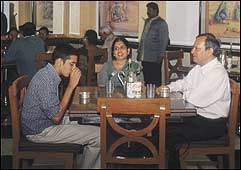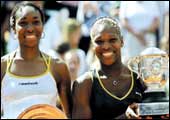|
You
heard him. If you didn't, here's what Finance Minister Yashwant
Sinha had to say on the tube: there's a recovery on (we've paraphrased
him) going by 'indicators' in certain sectors of the economy. April,
as the figures show (See Things Are Looking Up) was a good month.
''There have been some positive movements in certain parameters,
both on the domestic front and the global one, heralding a recovery,''
says Jiban K. Mukhopadhyay, an economic advisor to the Tata Group.
Then, almost as an afterthought, ''A modest one; we'll have to wait
till next year for a sharp upturn.''
Mukhopadhyay is right; things do look better on the global front
International Monetary Fund estimates put the world economy as growing
at 2.8 per cent in 2002, and 4 per cent the following year compared
to 2001's 2.5 per cent and world exports, according to World Bank
Report, will grow too, from a negative 1.5 per cent in 2001 to 1.5
per cent in 2002.
There's reason to cheer on the domestic front
too, and that's reflected in a Confederation of Indian Industry
(CII) study on business outlook: 56 per cent of CEOs surveyed claimed
they were ''confident about (business) prospects for the next six
months'' and plan to hike production, invest more, and add workforce.
None of this guarantees a better year. The
figures are for April and economists well know the perils of extrapolating
a year's performance from a month's. And last year was bad enough-industrial
growth plummeted to a nine-year low of 2.7 per cent; and growth
in the basic goods market fell from 3.9 per cent to 2.8 per cent-to
warrant being left out of any exercise in statistical comparison.
Recent reports, such as the one put out by
investment firm CSFB, may estimate this year's GDP growth rate at
6 per cent but if the momentum evident in April's figures wanes-and
there is a strong chance of that happening if the government doesn't
get down to the business of, well, business soon-we'll have to look
at a more achievable number of 5.5, even 5 per cent. Enjoy the good
times.
-Ashish
Gupta
IDLI-WIND
An Indian McDonald's
The Far East's Komalas can lay
claim to being the first global South Indian fast food chain, but
Chennai's own Saravanas isn't far behind.
 |
| Going Places: Saravanas wants to be big
in Singapore, US, and Australia |
Three
months ago 28-year-old R. Sivakumar, the son of the man behind Saravanas,
P. Rajagopal, took the famous-down-in-Chennai restaurant brand to
California and Singapore. Both boast a fair sprinkling of South
Indians; better still, idli (steamed dumpling) and dosa (rice pancake)
are global. The move was logical. Sivakumar was just building on
the raucuous reception Saravanas had received in Dubai, where an
outlet opened in December 2000. ''There were no vegetarian restaurants
in Dubai and when we took our brand there, the business just took
off from day one.'' Next stop: A presence in Australia and more
outlets in Singapore and the US.
A lucrative catering business bestows Saravanas'
business model with some solidity. The front-end was infotech-enabled
in 1994, and Sivakumar and his younger brother Saravanan scan management
information systems (MIS) reports to identify shifting customer
preferences.
As the next customer orders a serving of ghee
(clarified butter) idlis, a Saravanas speciality, the kitchen is
being infotech-enabled-an effort aimed at standardising ingredients
and cooking processes. McDonald's it ain't, but it could get there
someday.
-Nitya Varadarajan
BANGALORE'S
QUAINTEST
An enterprising Bangalore foodie
identifies a lucrative niche market.
 |
| B.S. Kishen: A yen for food |
The
Iyengars, a Brahmin sect who can be found in parts of Tamil Nadu
and Karnataka-TTK Group's T.T. Jaganathan and TVS Motor CEO Venu
Srinivasan are two-love their food. So, when 42-year-old Bindingnavle
Srinivasa Krishna Iyengar (B.S. Kishen, he calls himself) decided,
in 1995, that he would no longer work for someone, he decided to
focus on food. Or on Sakkare Pongal (a sweet dish made from boiled
rice, jaggery, and raisins), Kanchipuram Idli (a variety of steamed
dumpling), and Puliyogare (a spicy tamarind-flavoured rice), all
Iyengar specialities to be accurate. So, with an initial investment
of Rs 20 lakh, Kishen founded Kadambam (shorthand for Kadamba Sadam,
a rice-based dish) in the middler-than-middle Bangalore borough
of Jayanagar. And to differentiate Kadambam from the darshinis that
dot Bangalore, Kishen decided to focus on Iyengar cuisine and offer
seating space (the darshinis didn't). The strategy worked. The one
restaurant has grown to three; footfalls number 2,400 a day, and
the turnover, Rs 1.8 crore a year. And it all started because he
liked food.
-Venkatesha Babu
MATCH-LESS
Tennis, Anyone?
Soccer may not be a rage in India, but it didn't
help the French Open tennis tournament to be sandwiched between
the Indian cricket team's tour of West Indies and the FIFA World
Cup.
 |
| The Williams sisters: Game, set, and
match to cricket |
Even
the sibling rivalry between the sisters Williams-something that
bestowed a soap opera touch to the normally boring baseline game
that's the French Open's usual fare-couldn't work its magic on the
Indian audience. The timing of the tournament could have been better.
The French Open began on May 27 and ended on June 9. The Indian
cricket team's tour of West Indies culminated on June 2; and the
XVII FIFA World Cup kicked off on May 31. Indian viewers could have
caught glimpses of Roland Garros' brown clay starting June 6 if
they so desired (or if they happened to encounter it while searching
for Ten Sports).
DD Metro made a mere Rs 40 lakh in advertising
for the seven matches it broadcast. And viewership, even for the
high-interest match between Venus and Serena Williams, was a mere
0.21, as compared to an average of 2.6 per cent for the first four
matches of the World Cup. "Even though the World Cup happens
at non-prime time in India, advertisers will latch onto it as it
draws regular and consistent audience interest," explains Rajeev
Dhal, Group Head (Planning) of media-buyer Carat India. But at 7.8
per cent for the third one-day international between India and West
Indies, cricket rules.
-Shailesh Dobhal
MAROONED
The One That Got Left Behind
Time, and options, could be running out for
Andersen's consulting business.
 |
| N. Seshadri: Holding the fort, but for
whom? |
In the US, with each passing day
bringing a more damming disclosure about Andersen's complicity in
the Enron affair, the audit firm's name is mud. Bobby Parikh, who
managed to effect a merger of the Indian ops into Ernst & Young
and remain CEO of the merged entity, must be congratulating himself.
But what of Andersen's consulting business in India? E&Y, despite
a non-compete deal with Cap Gemini to which it sold its consulting
arm in 2000, was willing to let the division share its infrastructure,
but Narayan Seshadri, the division's head, demurred. The 130-man
entity, says Seshadri is in the midst of its annual strategy meeting,
but Business Today learns-and the consulting unit denies-that its
employees have informally been told that their jobs can be guaranteed
only till a certain date.
There is the KPMG Consulting angle, of course-the
firm has signed a letter of intent to buy 23 consulting operations
of Andersen including the one in India-but the deal is far from
done. The buzz is that the division is hedging its bets while it
awaits a visit from a international KPMG team by keeping the lines
open with the consulting arms of other large audit firms. Still,
time is running out for Seshadri & Co and in the business of
consulting, as everyone well knows, time is money.
-Seema Shukla
|

